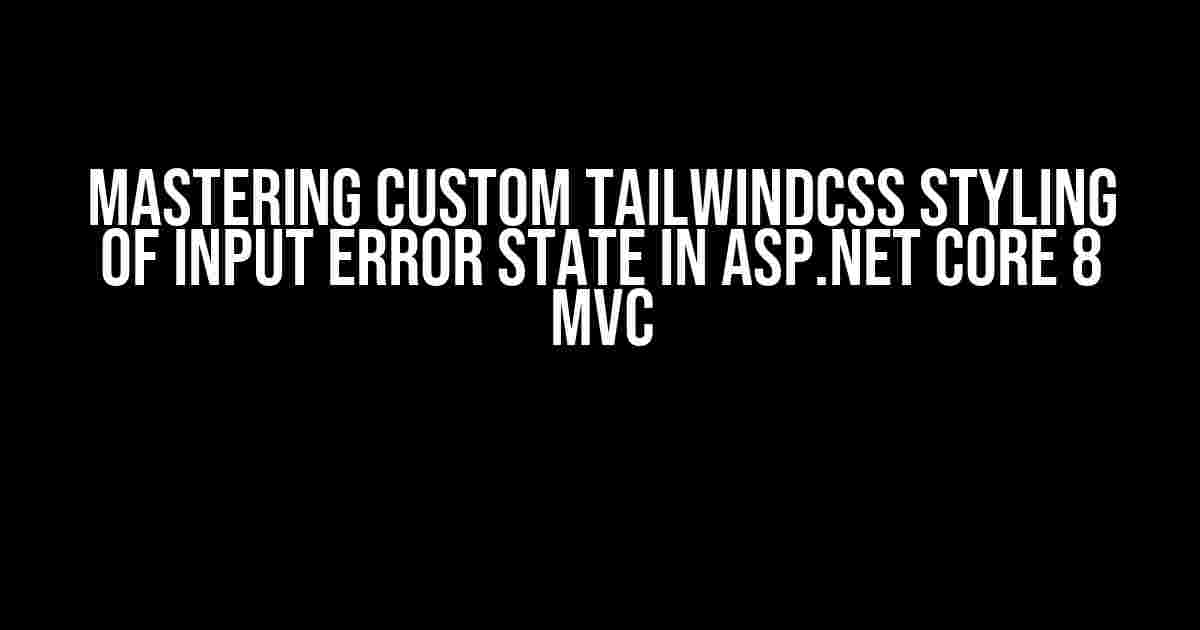Welcome to this comprehensive guide on customizing the input error state using TailwindCSS in ASP.NET Core 8 MVC. In this article, we’ll delve into the world of CSS magic, exploring the possibilities of TailwindCSS and its seamless integration with ASP.NET Core 8 MVC. By the end of this tutorial, you’ll be equipped with the skills to create visually appealing and user-friendly input error states that elevate your application’s overall user experience.
Why Custom Input Error Styling Matters
When it comes to building robust and engaging web applications, attention to detail is crucial. One often-overlooked aspect is the error state of input fields. A well-designed input error state can significantly enhance the user experience by providing clear visual cues, reducing frustration, and improving overall usability. In this article, we’ll show you how to take your input error styling to the next level using TailwindCSS and ASP.NET Core 8 MVC.
Prerequisites
To follow along with this tutorial, you’ll need:
- A basic understanding of ASP.NET Core 8 MVC and its Razor syntax
- Familiarity with CSS and CSS preprocessors (such as Sass or Less)
- TailwindCSS installed and configured in your ASP.NET Core 8 MVC project
Understanding ASP.NET Core 8 MVC’s Built-in Error Styling
Before we dive into customizing input error states, let’s take a look at how ASP.NET Core 8 MVC handles error styling out of the box. By default, ASP.NET Core 8 MVC uses the `input-validation-error` class to style input fields with invalid data. This class is applied to the input field’s wrapper element, typically a `div` element with the `form-control` class.
<div class="form-control"> <input type="text" asp-for="EmailAddress" /> <span asp-validation-for="EmailAddress"></span> </div>
The `input-validation-error` class is defined in the `_ValidationScriptsPartial.cshtml` file, which is included in the ASP.NET Core 8 MVC template. This class applies basic styling to the input field, such as a red border and text color.
Introducing TailwindCSS
TailwindCSS is a utility-first CSS framework that provides a set of pre-designed classes to style HTML elements. With TailwindCSS, you can write more concise and maintainable CSS code, focusing on the utility of each class rather than its visual representation. In the context of ASP.NET Core 8 MVC, we’ll use TailwindCSS to create custom input error states.
Configuring TailwindCSS in ASP.NET Core 8 MVC
To use TailwindCSS in your ASP.NET Core 8 MVC project, you’ll need to install the `TailwindCSS` NuGet package and configure it in your project. Here’s a brief overview of the process:
- Install the `TailwindCSS` NuGet package using the following command:
dotnet add package TailwindCSS - Create a new file called `tailwind.config.js` in the root of your project, and add the following configuration:
module.exports = {
mode: 'jit',
purge: [
'./Pages/**/*.{cshtml,razor}',
'./Views/**/*.{cshtml,razor}',
],
theme: {
extend: {},
},
variants: {},
plugins: [],
};
- In your `_Layout.cshtml` file, add the following script tag to include the TailwindCSS stylesheet:
<script src="_framework/tailwindcss.js"></script>
Customizing Input Error States with TailwindCSS
Now that we have TailwindCSS configured in our ASP.NET Core 8 MVC project, let’s create a custom input error state using its utility classes. We’ll create a new class called `input-error` that will be applied to the input field’s wrapper element when an error occurs.
<div class="form-control @if (!Model.IsValid) { @class="input-error" }">
<input type="text" asp-for="EmailAddress" />
<span asp-validation-for="EmailAddress"></span>
</div>
In our `tailwind.config.js` file, we’ll add the following configuration to define the `input-error` class:
module.exports = {
// ...
theme: {
extend: {
inputError: {
'&.input-error': {
'@apply border-red-500 hover:border-red-700 focus:border-red-600':
'focus:outline-none',
},
},
},
},
// ...
};
In this configuration, we’re using the `extend` property to define a new class called `input-error`. We’re applying the following styles to the input field when the `input-error` class is present:
- A red border with a hover state that changes to a darker red on hover
- A focus state that removes the outline and applies a slightly different border color
Enhancing the Error State with Additional Styles
To further enhance the input error state, we can add additional styles to provide more visual cues to the user. Let’s create a new class called `error-message` that will be applied to the error message span element:
<div class="form-control @if (!Model.IsValid) { @class="input-error" }">
<input type="text" asp-for="EmailAddress" />
<span class="error-message" asp-validation-for="EmailAddress"></span>
</div>
In our `tailwind.config.js` file, we’ll add the following configuration to define the `error-message` class:
module.exports = {
// ...
theme: {
extend: {
errorMessage: {
'&.error-message': {
'@apply text-red-600 text-sm':
'font-medium',
},
},
},
},
// ...
};
In this configuration, we’re applying the following styles to the error message span element:
- A red text color with a smaller font size
- A medium font weight to make the error message more prominent
Putting it all Together
To summarize, we’ve created a custom input error state using TailwindCSS in our ASP.NET Core 8 MVC project. We’ve defined two new classes, `input-error` and `error-message`, which provide clear visual cues to the user when an error occurs:
| Class | Description |
|---|---|
| input-error | Applied to the input field’s wrapper element when an error occurs, providing a red border and focus state. |
| error-message | Applied to the error message span element, providing a red text color, smaller font size, and medium font weight. |
By using TailwindCSS, we’ve created a highly customizable and maintainable solution for input error states in our ASP.NET Core 8 MVC application. With a few simple configurations, we’ve elevated the user experience and provided clear visual cues for error states.
Conclusion
In this article, we’ve explored the world of custom input error states in ASP.NET Core 8 MVC using TailwindCSS. By leveraging the utility-first approach of TailwindCSS, we’ve created a highly customizable and maintainable solution for input error states. Whether you’re building a complex enterprise application or a simple web app, the techniques outlined in this article will help you create a more engaging and user-friendly experience for your users.
Remember, the key to mastering custom input error states is to experiment and have fun with different utility classes and configurations. Don’t be afraid to try new things and push the boundaries of what’s possible with TailwindCSS and ASP.NET Core 8 MVC.
Happy coding, and we’ll see you in the next article!
Here are 5 Questions and Answers about “Custom TailwindCSS styling of input error state in ASP.NET Core 8 MVC”:
Frequently Asked Questions
Get the scoop on customizing input error states in ASP.NET Core 8 MVC with TailwindCSS!
How do I integrate TailwindCSS with ASP.NET Core 8 MVC?
To integrate TailwindCSS with ASP.NET Core 8 MVC, you need to install the TailwindCSS NuGet package and configure it in your .NET project. Then, create a `tailwind.config.js` file to customize your Tailwind settings and run the command `npx tailwindcss -i ./input.css -o ./output.css` to generate the CSS file. Finally, import the generated CSS file in your `_Layout.cshtml` file.
What is the default error state class in ASP.NET Core 8 MVC?
The default error state class in ASP.NET Core 8 MVC is `invalid`. You can customize this class by modifying the `ValidationMessageCssClass` property in your `Startup.cs` file.
How do I customize the error state styling using TailwindCSS utilities?
You can customize the error state styling by adding TailwindCSS utilities to the default error state class. For example, you can add `border-red-500` and `bg-red-100` to change the border and background color of the input field. You can also add `text-red-600` to change the text color of the error message.
Can I customize the error state styling for specific input types?
Yes, you can customize the error state styling for specific input types by adding custom CSS classes to the input elements. For example, you can add a `error-input-text` class for text inputs and a `error-input-email` class for email inputs. Then, you can define custom styles for each class using TailwindCSS utilities.
How do I handle error state styling for complex forms with multiple input fields?
For complex forms with multiple input fields, you can use a combination of TailwindCSS utilities and custom CSS classes to style the error state. You can also use ASP.NET Core 8 MVC’s built-in validation features, such as `ModelState.IsValid` and `ValidationSummary`, to handle error state styling at the form level.


